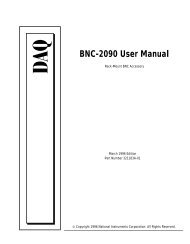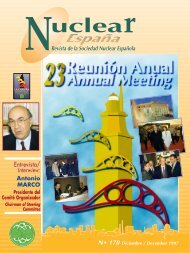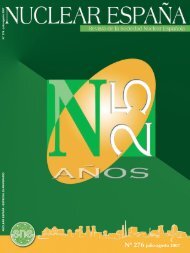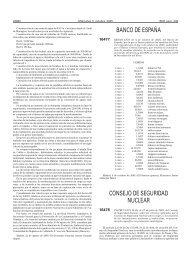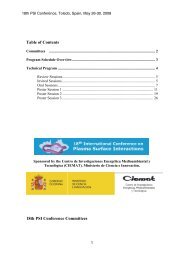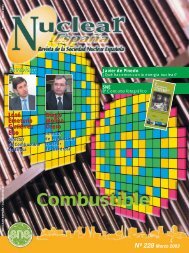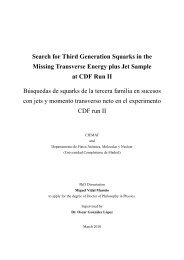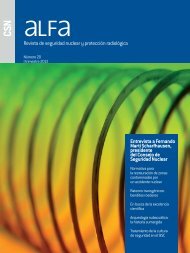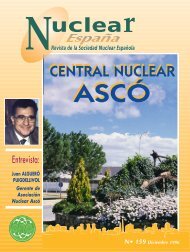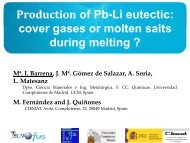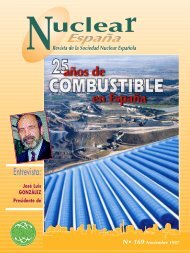EntrEntr evista/evista/ InterInter viewview
EntrEntr evista/evista/ InterInter viewview
EntrEntr evista/evista/ InterInter viewview
You also want an ePaper? Increase the reach of your titles
YUMPU automatically turns print PDFs into web optimized ePapers that Google loves.
from the evaluation that the radiological effect of the<br />
plant on living beings around the plant does not<br />
differ from values obtained from other environments<br />
not exposed to the influence of nuclear power<br />
plants.<br />
• Y2K computer adaptation: a program of<br />
activities was established to prepare all safety- and<br />
licensing-related computer systems for the transition<br />
to 2000.<br />
• The periodic safety review (PSR) was sent to the<br />
CSN on October 8, 1998. The period covered by the<br />
analysis was from completion of the modification<br />
program (25/10/85) to December 31, 1997. During<br />
the first six months of the year, the CSN undertook a<br />
continuous evaluation process of the PSR and<br />
concluded that the scope is adequate, the<br />
information included is correct and sufficient, and<br />
the plant can continue to operate without causing an<br />
undue risk to workers or the general public.<br />
Subsequently, the PSR was revised in order to correct<br />
discrepancies and complete the issues and omissions<br />
identified in the evaluation process.<br />
• Maintenance Rule: all final documentation,<br />
procedures and reports for implementation of the<br />
maintenance rule were prepared during 1999.<br />
Implementation of the Maintenance Rule in José<br />
Cabrera NPP began on April 1, 1999, and the<br />
effectiveness of maintenance activities on major<br />
safety-related structures / systems / components has<br />
been monitored to ensure that they are functioning<br />
properly.<br />
• Safety improvement program: on July 14, 1999,<br />
an extension of the José Cabrera NPP operating<br />
license was requested for a period of nine years as of<br />
October 17, 1999, based above all on the<br />
conclusions of the Periodic Safety Review. The<br />
Ministry of Industry and Energy granted the<br />
Operating License to the plant for three years, under<br />
the condition that a Safety Improvement Program be<br />
implemented. The improvement program is<br />
composed of two areas: one derived from the PSR<br />
that addresses operating experience, standards,<br />
equipment performance, probabilistic safety<br />
analysis, training, and severe accident management;<br />
the other area concerns control room design review,<br />
safety injection valve motorization, equipment<br />
reliability, emergency operating procedures, etc.<br />
• Organization: on June 28, National Power’s<br />
acquisition of a 25% share in Unión Fenosa<br />
Generation’s capital was formalized, maintaining the<br />
strategic alliance between Unión Fenosa and<br />
National Power announced in October of the<br />
preceding year.<br />
CURRENT STATUS AND PROSPECTS OF<br />
ZORITA<br />
The plant reached its 31st year on June 30, and<br />
during 1999 it operated correctly without any<br />
incidents that involved an undue risk to the<br />
population or environment.<br />
Production amounted to some 1,177 million KWh<br />
per year, which represents a load factor of about<br />
84% of the maximum attainable with installed<br />
power. This ranks the plant in the top third of the<br />
world’s 437 nuclear power plants in terms of load<br />
factor.<br />
The immediate prospects are to operate in the<br />
framework of the current Operating License in force<br />
until October 2002, and to implement the safety<br />
program improvements established in the Operating<br />
License in the next three years. The 24th refueling is<br />
scheduled for mid-July, with an estimated duration of<br />
37 days.<br />
completar las cuestiones y omisiones<br />
identificadas en el proceso de<br />
evaluación.<br />
• Regla de Mantenimiento: durante<br />
1999 se ha preparado toda la<br />
documentación final, procedimientos<br />
e informes, de implantación de<br />
la regla de mantenimiento. A partir<br />
del 1 de abril de 1999 se ha implantado<br />
en la C.N. de José Cabrera la<br />
Regla de Mantenimiento, vigilándose<br />
la efectividad de las actividades<br />
de mantenimiento en<br />
estructuras/sistemas/componentes<br />
importantes para la seguridad y garantizando<br />
su correcto funcionamiento.<br />
• Programa de mejora de la seguridad:<br />
el 14 de julio de 1999 se solicitó<br />
una prórroga al permiso de explotación<br />
de la C.N. de José<br />
Cabrera, por un periodo de nueve<br />
años a partir del 17 de octubre de<br />
1999, basándose de manera especial<br />
en las conclusiones de la<br />
Revisión Periódica de Seguridad. El<br />
Ministerio de Industria y Energía<br />
otorgó a la central el Permiso de<br />
Explotación(PE) por tres años, incluyendo<br />
la condición de realizar un<br />
Programa de Mejora de la<br />
Seguridad. El programa de mejora<br />
se compone de dos áreas, una derivada<br />
de la RPS que contempla experiencia<br />
operativa, normativa,<br />
comportamiento de equipos, análisis<br />
probabilista de seguridad, formación<br />
y gestión de accidentes severos.<br />
Por otra parte, la revisión de<br />
diseño de la sala de control, la motorización<br />
de válvulas de inyección<br />
de seguridad, fiabilidad de equipos,<br />
procedimientos de operación de<br />
emergencia, etc.<br />
• Organización: el 28 de junio se<br />
formalizo la toma de participación<br />
por National Power, del 25% del<br />
capital de Unión Fenosa Generación,<br />
manteniéndose la alianza<br />
estratégica entre Unión Fenosa y<br />
National Power anunciada en octubre<br />
del año anterior.<br />
ESTADO ACTUAL Y<br />
PERSPECTIVAS DE ZORITA<br />
La central cumplió 31 años el pasado<br />
30 de junio y durante el año<br />
1999 ha funcionado correctamente,<br />
sin incidencias que hayan supuesto<br />
un riesgo indebido para la población<br />
o el medio ambiente.<br />
La producción alcanzada de unos<br />
1.177 millones de kwh al año, que<br />
representa un factor de carga del orden<br />
del 84% del máximo alcanzable<br />
con la potencia instalada, sitúa<br />
a la central en el primer tercio de<br />
las 437 centrales nucleares en el<br />
mundo en orden de factores de carga.<br />
Las perspectivas próximas son<br />
operar en el marco del Permiso de<br />
Explotación vigente hasta octubre<br />
del 2002 e implantar las mejoras<br />
del programa de seguridad establecido<br />
en el PE en los próximos tres<br />
años. La 24 recarga esta pr<strong>evista</strong> a<br />
mediados de julio con una duración<br />
estimada de 37 días.<br />
CN VANDELLîS II<br />
Ángel Fernández Camblor<br />
El año 1999 ha sido realmente un<br />
año muy importante para CN<br />
Vandellós II; las grandes modificaciones,<br />
los cambios tecnológicos y<br />
las mejoras introducidas durante la<br />
10ª Recarga, así como el profundo<br />
cambio organizativo realizado marcarán<br />
fuertemente nuestro futuro.<br />
Si nos centramos en el funcionamiento<br />
de la central, un año más<br />
debemos decir que éste ha sido<br />
bueno, generándose una producción<br />
bruta de 7.538 GWh con un<br />
factor de carga del 81,54%. A<br />
31.12.99 se habían generado desde<br />
la primera sincronización 88.055<br />
GWh brutos, que dan un factor de<br />
carga medio de 83%.<br />
La indisponibilidad no programada<br />
del 3,91% fue consecuencia<br />
principalmente de:<br />
• Tres intervenciones en el condensador<br />
para localizar y reparar<br />
entradas de agua de mar al circuito<br />
secundario.<br />
• La parada automática del reactor<br />
durante la prueba de rechazo de<br />
carga del 50% el 11 de mayo.<br />
• El fallo de la bomba C de condensado<br />
por un problema eléctrico<br />
en el motor.<br />
• La parada automática del reactor<br />
como consecuencia de la apertura<br />
intempestiva del interruptor de<br />
salida de máquina en fecha<br />
12.07.99<br />
• Una entrada de aire al condensador<br />
que provocó pérdida de vacío.<br />
La indisponibilidad programada<br />
del 14,55% se debió a:<br />
• El alargamiento del ciclo para<br />
acomodarlo a la fecha de parada<br />
para recarga.<br />
• La propia parada de recarga.<br />
A b r i l 2 0 0 0<br />
R e v i s t a S N E




